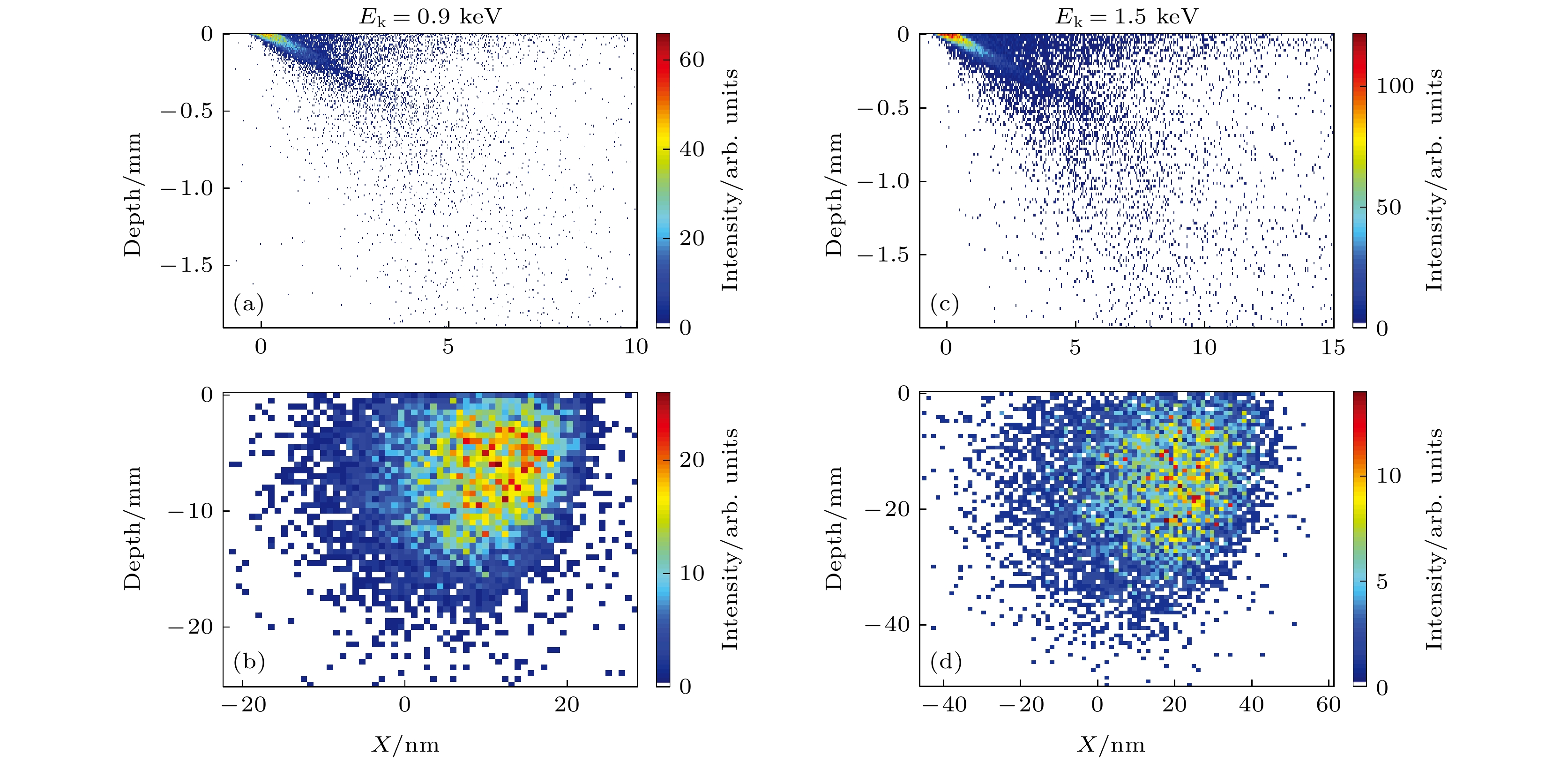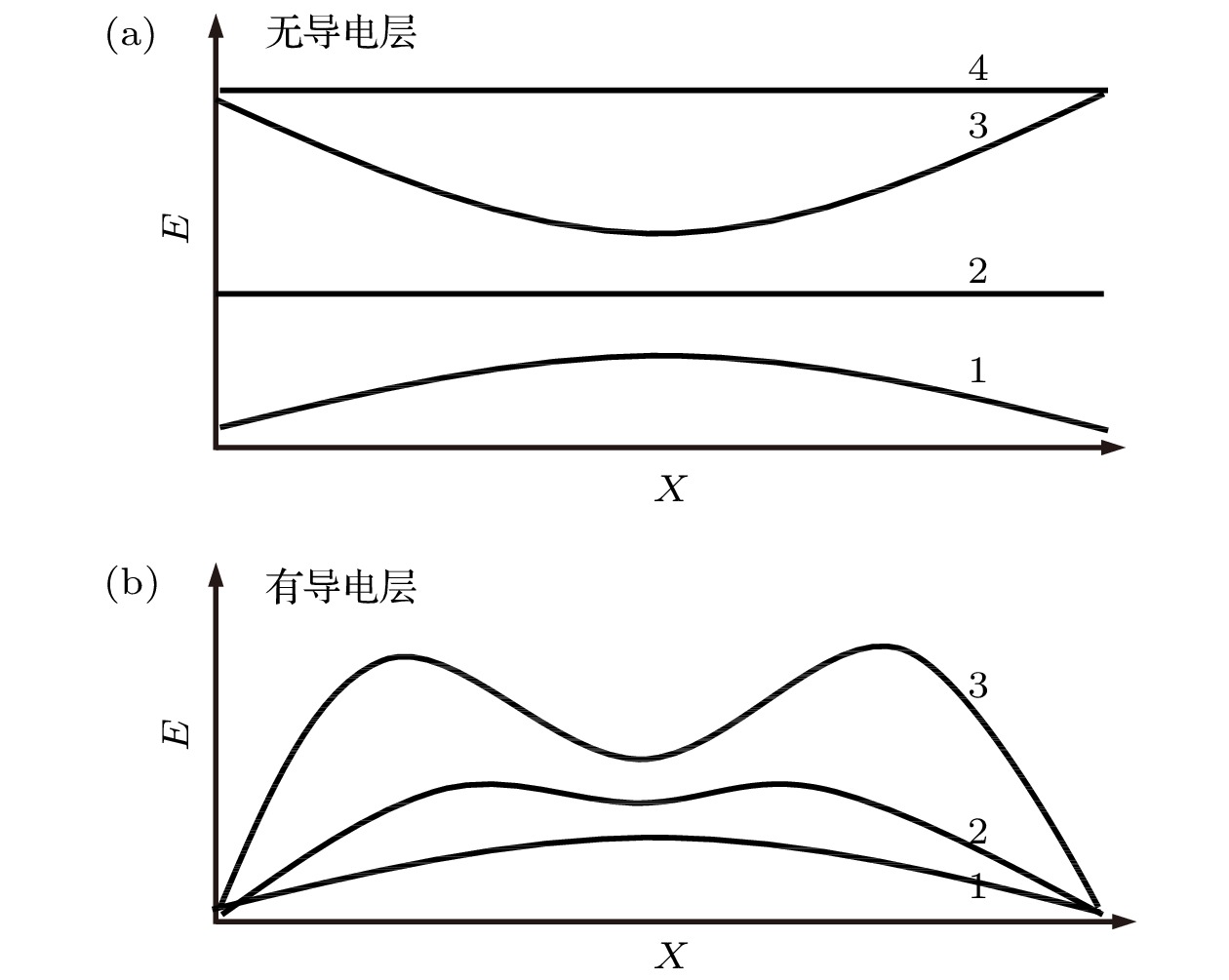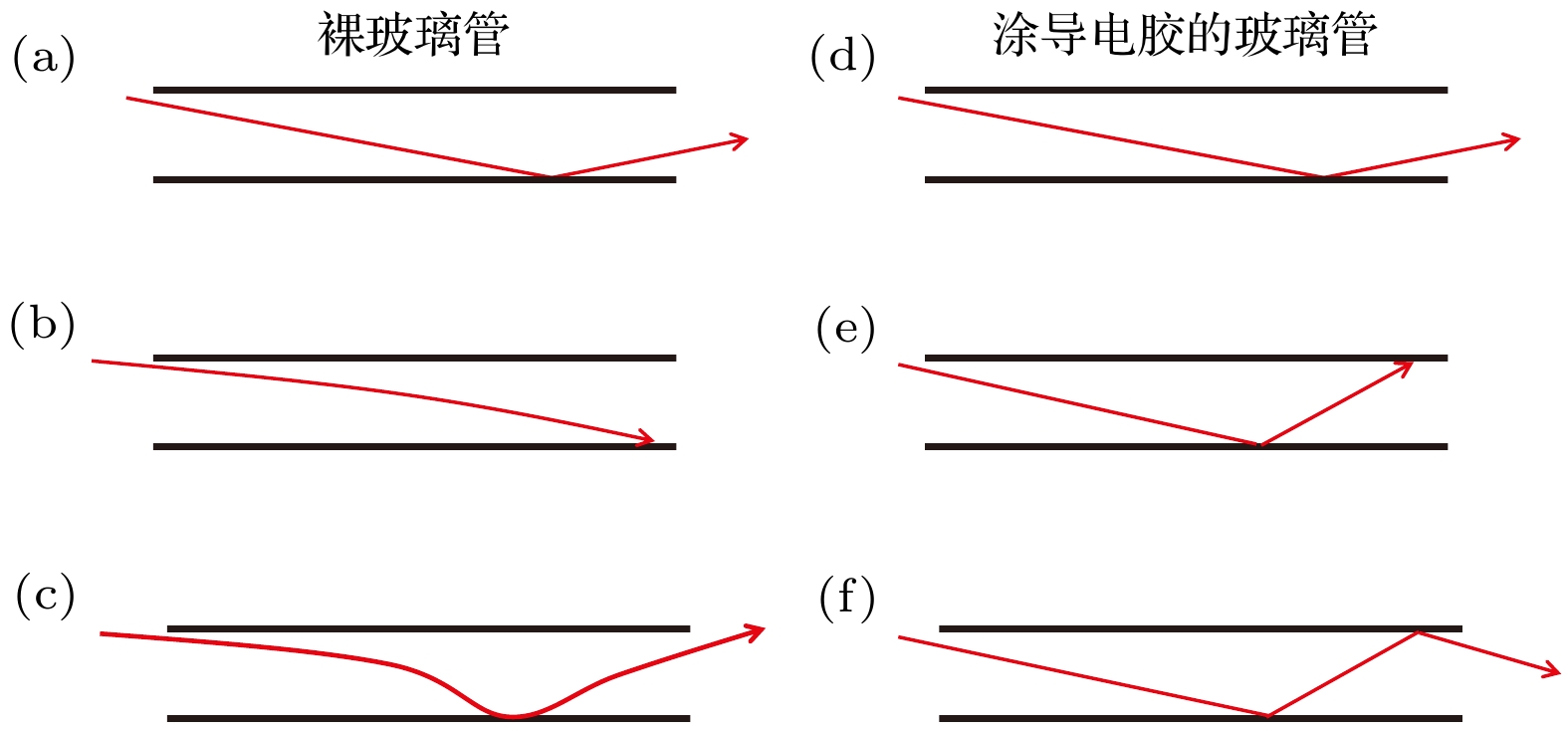-
分别对裸的直玻璃管和外壁与出入口两端面涂导电银胶的直玻璃管进行了低能电子穿透实验. 穿透电子的倾角分布显示, 穿透电子强度随倾角增大而减少, 并且穿透倾角不会超过玻璃管的几何张角. 还测量了玻璃管在倾角为–0.2°时的充电过程. 对于裸玻璃管, 在充电过程中, 穿透率和角分布有显著的振荡现象. 整体来看, 穿透率随时间先下降后上升, 最后在某个平均值附近振荡; 角分布随穿透率变化同步变化, 先向正角度移动再向负角度移动, 最后在玻璃管的倾角附近振荡. 对于涂导电胶的玻璃管, 在充电过程中, 穿透率和角分布稳定变化. 穿透率随时间先下降后上升最后平稳, 角分布随时间先向负角度移动再向正角度移动, 最后在玻璃管倾角附近稳定. 通过模拟电子与SiO2材料的碰撞过程, 提出了电子在裸玻璃管和涂导电胶玻璃管中的充电过程的物理图像. 该物理图像能很好地解释电子在裸玻璃管和涂导电胶的玻璃管中充电过程的实验结果. 最后, 依据实验结果和物理图像给出了低能电子在玻璃毛细管中稳定输运的条件.
The electron microbeam is useful for modifying certain fragments of biomolecule. It is successful to apply the guiding effect to making the microbeam of positively charged particles by using single glass capillary. However, the mechanism for the electron transport through insulating capillaries is unclear. Meanwhile, previous researches show that there are oscillations of the transmission intensity of electrons with time in the glass capillaries with outer serface having no grounded conductive shielding, So, the application of glass capillary to making the microbeam of electrons is limited. In this paper, the transmission of 1.5 and 0.9 keV electrons through the glass capillary without/with the grounded conductive-coated outer surface are investigated, respectively. This study aims to understand the mechanism for low energy electron transport in the glass capillaries, and find the conditions for the steady transport of the electrons. Two-dimensional angular distribution of the transported electrons and its time evolution are measured. It is found that the intensity of the transported electrons with the incident energy through the glass capillaries for the glass capillaries without and with the grounded conductive-coated outer surface show the typical geometrical transmission characteristics. The time evolution of the 1.5- keV electron transport presents an extremely complex variation for the glass capillary without the grounded conductive-coated outer surface. The intensity first falls, then rises and finally oscillates around a certain mean value. Correspondingly, the angular distribution center experiences moving towards positive-negative-settlement. In comparison, the charge-up process of the 0.9 keV electron transport through the glass capillary with the grounded conductive-coated outer surface shows a relatively simple behavior. At first, the intensity declines rapidly with time. Then, it slowly rises till a certain value and stays steady subsequently. The angular distribution of transported electrons follows the intensity distribution in general, but with some delay. It quickly moves to negative direction then comes back to positive direction. Finally, it regresses extremely slowly and ends up around the tilt angle. To better understand the physics behind the observed phenomena, the simulation for the interaction of the electrons with SiO2 material is performed to obtain the possible deposited charge distribution by the CASINO code. Based on the analysis of the experimental results and the simulated charge deposition, the conditions for stabilizing the electron transport through glass capillary arepresented. -
Keywords:
- electron guiding /
- secondary electron /
- charge deposition /
- glass capillary
[1] Kumar A, Becker D, Adhikary A, Sevilla M D 2019 Int. J. Mol. Sci. 20 3998
 Google Scholar
Google Scholar
[2] Baccarelli I, Bald I, Gianturco F A, Illenberger E, Kopyra J 2011 Phys. Rep. 508 1
 Google Scholar
Google Scholar
[3] Iwai Y, Ikeda T, Kojima T M, Yamazaki Y, Maeshima K, Imamoto N, Kobayashi T, Nebiki T, Narusawa T, Pokhil G P 2008 Appl. Phys. Lett. 92 023509
 Google Scholar
Google Scholar
[4] Stolterfoht N, Bremer J H, Hoffmann V, Hellhammer R, Fink D, Petrov A, Sulik B 2002 Phys. Rev. Lett. 88 133201
 Google Scholar
Google Scholar
[5] Zhang H Q, Skog P, Schuch R 2010 Phys. Rev. A 82 052901
 Google Scholar
Google Scholar
[6] Skog P, Zhang H, Schuch R 2008 Phys. Rev. Lett. 101 223202
 Google Scholar
Google Scholar
[7] Juhász Z, Sulik B, Rácz R, Biri S, Bereczky R, Tőkési K, Kövér Á, Pálinkás J, Stolterfoht N 2010 Phys. Rev. A 82 062903
 Google Scholar
Google Scholar
[8] Hellhammer R, Pešic Z, Sobocinski P, Fink D, Bundesmann J, Stolterfoht N 2005 Nucl. Instrum. Methods Phys. Res. , Sect. B 233 213
 Google Scholar
Google Scholar
[9] Skog P, Soroka I L, Johansson A, Schuch R 2007 Nucl. Instrum. Metods Phys. Res., Sect. B 258 145
 Google Scholar
Google Scholar
[10] Chen Y F, C X M, Lou F J, Xu J Z, Shao J X, Sun G Z, Wang J, Xi F Y, Yin Y Z, Wang X A, Xu J K, Cui Y, Ding B W 2009 Chin. Phys. B 18 2739
 Google Scholar
Google Scholar
[11] Juhász Z, Sulik B, Biri S, Iván I, Tőkési K, Fekete É, Mátéfi-Tempfli S, Mátéfi-Tempfli M, Víkor G, Takács E 2009 Nucl. Instrum. Methods Phys. Res. , Sect. B 267 321
 Google Scholar
Google Scholar
[12] Sahana M, Skog P, Vikor G, Kumar R R, Schuch R 2006 Phys. Rev. A 73 040901
 Google Scholar
Google Scholar
[13] Stolterfoht N, Hellhammer R, Sulik B, Juhász Z, Bayer V, Trautmann C, Bodewits E, Hoekstra R 2011 Phys. Rev. A 83 062901
 Google Scholar
Google Scholar
[14] Juhász Z, Kovács S, Herczku P, Rácz R, Biri S, Rajta I, Gál G, Szilasi S, Pálinkás J, Sulik B 2012 Nucl. Instrum. Methods Phys. Res. , Sect. B 279 177
 Google Scholar
Google Scholar
[15] Zhang H, Akram N, Soroka I L, Trautmann C, Schuch R 2012 Phys. Rev. A 86 022901
 Google Scholar
Google Scholar
[16] Zhang H Q, Akram N, Skog P, Soroka I L, Trautmann C, Schuch R 2012 Phys. Rev. Lett. 108 193202
 Google Scholar
Google Scholar
[17] Zhang H, Akram N, Schuch R 2016 Phys. Rev. A 94 032704
 Google Scholar
Google Scholar
[18] Ikeda T, Kanai Y, Kojima T M, Iwai Y, Kambara T, Yamazaki Y, Hoshino M, Nebiki T, Narusawa T 2006 Appl. Phys. Lett. 89 163502
 Google Scholar
Google Scholar
[19] Cassimi A, Maunoury L, Muranaka T, Huber B, Dey K R, Lebius H, Lelièvre D, Ramillon J M, Been T, Ikeda T 2009 Nucl. Instrum. Methods Phys. Res., Sect. B 267 674
 Google Scholar
Google Scholar
[20] Nakayama R, Tona M, Nakamura N, Watanabe H, Yoshiyasu N, Yamada C, Yamazaki A, Ohtani S, Sakurai M 2009 Nucl. Instrum. Methods Phys. Res., Sect. B 267 2381
 Google Scholar
Google Scholar
[21] Giglio E, Guillous S, Cassimi A, Zhang H, Nagy G, Töőkési K 2017 Phys. Rev. A 95 030702
 Google Scholar
Google Scholar
[22] Giglio E, Guillous S, Cassimi A 2018 Phys. Rev. A 98 052704
 Google Scholar
Google Scholar
[23] Lemell C, Burgdörfer J, Aumayr F 2013 Prog. Surf. Sci. 88 237
 Google Scholar
Google Scholar
[24] Stolterfoht N, Yamazaki Y 2016 Phys. Rep. 629 1
 Google Scholar
Google Scholar
[25] Stolterfoht N, Tanis J 2018 Nucl. Instrum. Methods Phys. Res. , Sect. B 421 32
 Google Scholar
Google Scholar
[26] Milosavljević A, Víkor G, Pešić Z, Kolarž P, Šević D, Marinković B, Mátéfi-Tempfli S, Mátéfi-Tempfli M, Piraux L 2007 Phys. Rev. A 75 030901
 Google Scholar
Google Scholar
[27] Milosavljević A, Schiessl K, Lemell C, Tőkési K, Mátéfi-Tempfli M, Mátéfi-Tempfli S, Marinković B, Burgdörfer J 2012 Nucl. Instrum. Methods Phys. Res. , Sect. B 279 190
 Google Scholar
Google Scholar
[28] Das S, Dassanayake B, Winkworth M, Baran J, Stolterfoht N, Tanis J 2007 Phys. Rev. A 76 042716
 Google Scholar
Google Scholar
[29] Dassanayake B, Keerthisinghe D, Wickramarachchi S, Ayyad A, Das S, Stolterfoht N, Tanis J 2013 Nucl. Instrum. Methods. Phys. Res. , Sect. B 298 1
 Google Scholar
Google Scholar
[30] Keerthisinghe D, Dassanayake B, Wickramarachchi S, Stolterfoht N, Tanis J 2013 Nucl. Instrum. Methods Phys. Res. , Sect. B 317 105
 Google Scholar
Google Scholar
[31] Schiessl K, Tőkési K, Solleder B, Lemell C, Burgdörfer J 2009 Phys. Rev. Lett. 102 163201
 Google Scholar
Google Scholar
[32] Dassanayake B, Das S, Bereczky R, Tőkési K, Tanis J 2010 Phys. Rev. A 81 020701
 Google Scholar
Google Scholar
[33] Dassanayake B, Bereczky R, Das S, Ayyad A, Tökési K, Tanis J 2011 Phys. Rev. A 83 012707
 Google Scholar
Google Scholar
[34] Wickramarachchi S, Ikeda T, Dassanayake B, Keerthisinghe D, Tanis J 2016 Phys. Rev. A 94 022701
 Google Scholar
Google Scholar
[35] Wickramarachchi S, Ikeda T, Dassanayake B, Keerthisinghe D, Tanis J 2016 Nucl. Instrum. Methods Phys. Res., Sect. B 382 60
 Google Scholar
Google Scholar
[36] 万城亮, 李鹏飞, 钱立冰, 靳博, 宋光银, 高 志民, 周利华, 张琦, 宋张勇, 杨治虎, 邵剑雄, 崔莹, Reinhold Schuch, 张红强, 陈熙萌 2016 物理学报 65 204103
 Google Scholar
Google Scholar
Wan C L, Li P F, Qian L B, Jin B, Song G Y, Gao Z M, Zhou L H, Zhang Q, Song Z Y, Yang Z H, Shao J X, Cui Y, Reinhold S, Zhang H Q, Chen M 2016 Acta Phys. Sin. 65 204103
 Google Scholar
Google Scholar
[37] 钱立冰, 李鹏飞, 靳博, 靳定坤, 宋光银, 张琦, 魏龙, 牛犇, 万成亮, 周春林, Arnold Milenko Mscrir, Max Dobeli, 宋张勇, 杨治虎, Reinhold Schuch, 张红强, 陈熙萌 2017 物理学报 66 124101
 Google Scholar
Google Scholar
Qian L B, Li P F, Jin B, Jin D K, Song G Y, Zhang Q, Wei L, Niu B, Wan C L, Zhou C L, Arnold Milenko M, Max D, Song Z Y, Yang Z H, Reinhold S, Zhang H Q, Chen X M 2017 Acta Phys. Sin. 66 124101
 Google Scholar
Google Scholar
[38] Drouin D, Couture A R, Gauvin R, Hovington P, Horny P, Demers H 2016 Computer Code CASINO, Version 3.3, https://www.gel.usherbrooke.ca/casino/index.html
[39] Yang L, Da B, Tokesi K, Ding Z J 2021 Sci. Rep. 11 5954
 Google Scholar
Google Scholar
-
图 1 (a)实验设备示意图; (b)裸玻璃管和涂导电胶玻璃管的示意图
Fig. 1. (a) Schematic drawing of the experimental setup. The tilt angle α between the axis of the glass capillary and the electron beam, the observation angles φ and θ relative to the direction of the electron beam are indicated; (b) schematic drawing of the glass capillary, bare (above), silver conductive paint brushed (below).
图 2 1.5和0.9 keV电子分别穿越裸玻璃毛细管(a)和涂导电胶玻璃毛细管(b)的穿透率随倾角变化的分布曲线. 图中, 虚线之间的角度代表几何穿透角. 图(b)中, 红线是高斯拟合线
Fig. 2. The steady-state values of the transmission rate as a function of the tilt angle for 1.5 keV electrons through bare glass capillary (a) and 0.9 keV electrons through conductive-coated glass capillary (b). The dash lines indicate the geometric transmission angle of 1.68º spread angle. The red solid line is a Gaussian fit curve of the measured 0.9 keV data.
图 3 对倾角为–0.2°的裸玻璃毛细管(a), (b), (c)和涂导电胶的玻璃毛细管(d), (e), (f)的充电过程的测量. 图(a)和图(d)分别为1.5和0.9 keV电子的穿透率随时间演化曲线; 图(b)和图(e)分别为1.5和0.9 keV能量下的穿透电子在φ平面的投影中心随时间的演化曲线; 图(c)和图(f)为充电过程中选取的穿透电子的二维角分布图像; 每个图像分别对应图(a)和图(c)中画红圈的位置
Fig. 3. Measurements of the charge-up process in the glass capillary at certain tilt angle (α = –0.2°). Investigations conducted with both electron energies of 1.5 and 0.9 keV. (a) and (d) show the measured time evolution of the transmission rates. (b) and (e) show the projection of the transmitted electron angular distribution on the φ-plane. (c) and (f) show the 2 D images of electron angular distribution at different stages during the charge-up process. Each image in Figure (c) and Figure (f) corresponds to a red circle as marked in Figure (a) and Figure (d), respectively.
图 4 0.9 keV电子在入射角为7.1°时造成的空穴深度分布(a)和电子沉积深度分布(b); 1.5 keV的电子在入射角为5.5°时造成的空穴深度分布(c)和电子沉积深度分布(d). X 方向为毛细管轴向方向, X正向方向为入射电子具有最大动量的方向, (0, 0)位置为碰撞点
Fig. 4. The holes distribution (a), (c) and deposited electrons distribution (b), (d) in depth for 0.9 keV electrons at tilt angle 7.1°(a), (b) and 1.5 keV electrons at tilt angle 5.5°(c), (d). The impact occurred at the (0, 0) point.
-
[1] Kumar A, Becker D, Adhikary A, Sevilla M D 2019 Int. J. Mol. Sci. 20 3998
 Google Scholar
Google Scholar
[2] Baccarelli I, Bald I, Gianturco F A, Illenberger E, Kopyra J 2011 Phys. Rep. 508 1
 Google Scholar
Google Scholar
[3] Iwai Y, Ikeda T, Kojima T M, Yamazaki Y, Maeshima K, Imamoto N, Kobayashi T, Nebiki T, Narusawa T, Pokhil G P 2008 Appl. Phys. Lett. 92 023509
 Google Scholar
Google Scholar
[4] Stolterfoht N, Bremer J H, Hoffmann V, Hellhammer R, Fink D, Petrov A, Sulik B 2002 Phys. Rev. Lett. 88 133201
 Google Scholar
Google Scholar
[5] Zhang H Q, Skog P, Schuch R 2010 Phys. Rev. A 82 052901
 Google Scholar
Google Scholar
[6] Skog P, Zhang H, Schuch R 2008 Phys. Rev. Lett. 101 223202
 Google Scholar
Google Scholar
[7] Juhász Z, Sulik B, Rácz R, Biri S, Bereczky R, Tőkési K, Kövér Á, Pálinkás J, Stolterfoht N 2010 Phys. Rev. A 82 062903
 Google Scholar
Google Scholar
[8] Hellhammer R, Pešic Z, Sobocinski P, Fink D, Bundesmann J, Stolterfoht N 2005 Nucl. Instrum. Methods Phys. Res. , Sect. B 233 213
 Google Scholar
Google Scholar
[9] Skog P, Soroka I L, Johansson A, Schuch R 2007 Nucl. Instrum. Metods Phys. Res., Sect. B 258 145
 Google Scholar
Google Scholar
[10] Chen Y F, C X M, Lou F J, Xu J Z, Shao J X, Sun G Z, Wang J, Xi F Y, Yin Y Z, Wang X A, Xu J K, Cui Y, Ding B W 2009 Chin. Phys. B 18 2739
 Google Scholar
Google Scholar
[11] Juhász Z, Sulik B, Biri S, Iván I, Tőkési K, Fekete É, Mátéfi-Tempfli S, Mátéfi-Tempfli M, Víkor G, Takács E 2009 Nucl. Instrum. Methods Phys. Res. , Sect. B 267 321
 Google Scholar
Google Scholar
[12] Sahana M, Skog P, Vikor G, Kumar R R, Schuch R 2006 Phys. Rev. A 73 040901
 Google Scholar
Google Scholar
[13] Stolterfoht N, Hellhammer R, Sulik B, Juhász Z, Bayer V, Trautmann C, Bodewits E, Hoekstra R 2011 Phys. Rev. A 83 062901
 Google Scholar
Google Scholar
[14] Juhász Z, Kovács S, Herczku P, Rácz R, Biri S, Rajta I, Gál G, Szilasi S, Pálinkás J, Sulik B 2012 Nucl. Instrum. Methods Phys. Res. , Sect. B 279 177
 Google Scholar
Google Scholar
[15] Zhang H, Akram N, Soroka I L, Trautmann C, Schuch R 2012 Phys. Rev. A 86 022901
 Google Scholar
Google Scholar
[16] Zhang H Q, Akram N, Skog P, Soroka I L, Trautmann C, Schuch R 2012 Phys. Rev. Lett. 108 193202
 Google Scholar
Google Scholar
[17] Zhang H, Akram N, Schuch R 2016 Phys. Rev. A 94 032704
 Google Scholar
Google Scholar
[18] Ikeda T, Kanai Y, Kojima T M, Iwai Y, Kambara T, Yamazaki Y, Hoshino M, Nebiki T, Narusawa T 2006 Appl. Phys. Lett. 89 163502
 Google Scholar
Google Scholar
[19] Cassimi A, Maunoury L, Muranaka T, Huber B, Dey K R, Lebius H, Lelièvre D, Ramillon J M, Been T, Ikeda T 2009 Nucl. Instrum. Methods Phys. Res., Sect. B 267 674
 Google Scholar
Google Scholar
[20] Nakayama R, Tona M, Nakamura N, Watanabe H, Yoshiyasu N, Yamada C, Yamazaki A, Ohtani S, Sakurai M 2009 Nucl. Instrum. Methods Phys. Res., Sect. B 267 2381
 Google Scholar
Google Scholar
[21] Giglio E, Guillous S, Cassimi A, Zhang H, Nagy G, Töőkési K 2017 Phys. Rev. A 95 030702
 Google Scholar
Google Scholar
[22] Giglio E, Guillous S, Cassimi A 2018 Phys. Rev. A 98 052704
 Google Scholar
Google Scholar
[23] Lemell C, Burgdörfer J, Aumayr F 2013 Prog. Surf. Sci. 88 237
 Google Scholar
Google Scholar
[24] Stolterfoht N, Yamazaki Y 2016 Phys. Rep. 629 1
 Google Scholar
Google Scholar
[25] Stolterfoht N, Tanis J 2018 Nucl. Instrum. Methods Phys. Res. , Sect. B 421 32
 Google Scholar
Google Scholar
[26] Milosavljević A, Víkor G, Pešić Z, Kolarž P, Šević D, Marinković B, Mátéfi-Tempfli S, Mátéfi-Tempfli M, Piraux L 2007 Phys. Rev. A 75 030901
 Google Scholar
Google Scholar
[27] Milosavljević A, Schiessl K, Lemell C, Tőkési K, Mátéfi-Tempfli M, Mátéfi-Tempfli S, Marinković B, Burgdörfer J 2012 Nucl. Instrum. Methods Phys. Res. , Sect. B 279 190
 Google Scholar
Google Scholar
[28] Das S, Dassanayake B, Winkworth M, Baran J, Stolterfoht N, Tanis J 2007 Phys. Rev. A 76 042716
 Google Scholar
Google Scholar
[29] Dassanayake B, Keerthisinghe D, Wickramarachchi S, Ayyad A, Das S, Stolterfoht N, Tanis J 2013 Nucl. Instrum. Methods. Phys. Res. , Sect. B 298 1
 Google Scholar
Google Scholar
[30] Keerthisinghe D, Dassanayake B, Wickramarachchi S, Stolterfoht N, Tanis J 2013 Nucl. Instrum. Methods Phys. Res. , Sect. B 317 105
 Google Scholar
Google Scholar
[31] Schiessl K, Tőkési K, Solleder B, Lemell C, Burgdörfer J 2009 Phys. Rev. Lett. 102 163201
 Google Scholar
Google Scholar
[32] Dassanayake B, Das S, Bereczky R, Tőkési K, Tanis J 2010 Phys. Rev. A 81 020701
 Google Scholar
Google Scholar
[33] Dassanayake B, Bereczky R, Das S, Ayyad A, Tökési K, Tanis J 2011 Phys. Rev. A 83 012707
 Google Scholar
Google Scholar
[34] Wickramarachchi S, Ikeda T, Dassanayake B, Keerthisinghe D, Tanis J 2016 Phys. Rev. A 94 022701
 Google Scholar
Google Scholar
[35] Wickramarachchi S, Ikeda T, Dassanayake B, Keerthisinghe D, Tanis J 2016 Nucl. Instrum. Methods Phys. Res., Sect. B 382 60
 Google Scholar
Google Scholar
[36] 万城亮, 李鹏飞, 钱立冰, 靳博, 宋光银, 高 志民, 周利华, 张琦, 宋张勇, 杨治虎, 邵剑雄, 崔莹, Reinhold Schuch, 张红强, 陈熙萌 2016 物理学报 65 204103
 Google Scholar
Google Scholar
Wan C L, Li P F, Qian L B, Jin B, Song G Y, Gao Z M, Zhou L H, Zhang Q, Song Z Y, Yang Z H, Shao J X, Cui Y, Reinhold S, Zhang H Q, Chen M 2016 Acta Phys. Sin. 65 204103
 Google Scholar
Google Scholar
[37] 钱立冰, 李鹏飞, 靳博, 靳定坤, 宋光银, 张琦, 魏龙, 牛犇, 万成亮, 周春林, Arnold Milenko Mscrir, Max Dobeli, 宋张勇, 杨治虎, Reinhold Schuch, 张红强, 陈熙萌 2017 物理学报 66 124101
 Google Scholar
Google Scholar
Qian L B, Li P F, Jin B, Jin D K, Song G Y, Zhang Q, Wei L, Niu B, Wan C L, Zhou C L, Arnold Milenko M, Max D, Song Z Y, Yang Z H, Reinhold S, Zhang H Q, Chen X M 2017 Acta Phys. Sin. 66 124101
 Google Scholar
Google Scholar
[38] Drouin D, Couture A R, Gauvin R, Hovington P, Horny P, Demers H 2016 Computer Code CASINO, Version 3.3, https://www.gel.usherbrooke.ca/casino/index.html
[39] Yang L, Da B, Tokesi K, Ding Z J 2021 Sci. Rep. 11 5954
 Google Scholar
Google Scholar
计量
- 文章访问数: 7370
- PDF下载量: 109
- 被引次数: 0














 下载:
下载:





